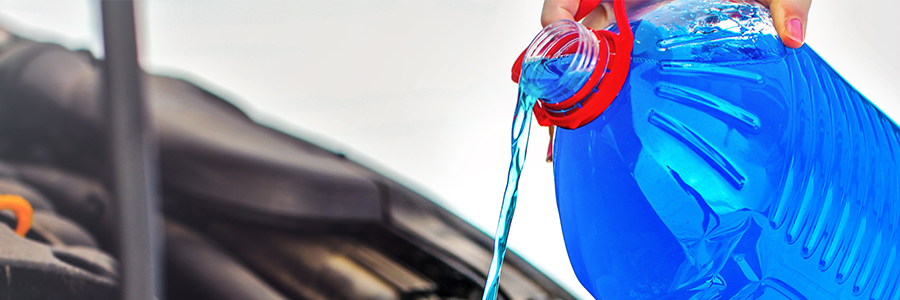RV Antifreeze FAQ

When the temperature drops this winter, don’t be left out in the cold! If you are planning to park your RV during the off season, then using RV antifreeze will be an essential part of the winterization process. Here at South Thompson, we want to help make sure that your RV stays in tip-top shape, so that you can protect your investment and keep making memories for years to come. That’s why we’ve rounded up some of the hottest tips for handling antifreeze in your RV this winter!
When and Why do I Need Antifreeze in my RV?
The purpose of antifreeze is just as its name describes: to stop water from freezing by lowering the freezing point of H2O. Your RV systems are full of water, such as in the pipes and hoses that run through your toilet, sinks and shower. If water is still sitting in these systems when the temperature drops below zero degrees, that water can freeze and cause major damage throughout your RV. This can result in costly repairs and a late start to your camping season in the spring. Even if you completely drain the lines, moisture droplets can remain throughout the system - hence the need for antifreeze! You’ll want to get the ball rolling on winterizing your RV in the fall once you’ve finished your camping season and you’re ready to park your RV for the winter. Getting a head start on winterizing your water lines will help make sure you can chill out when the winter chill sets in!
RV Antifreeze 101
It’s important to note that RV antifreeze is not the same as antifreeze you use in your car. RV antifreeze is non-toxic and designed for use in the plumbing systems of your RV, whereas automotive antifreeze is often toxic and can only be used in the engine cooling system of your car. You can usually tell them apart by their colour - RV antifreeze is pink and automotive antifreeze is typically green. You can buy RV antifreeze from just about any home improvement store, online, or from your trusted local RV shop like South Thompson! Our staff will make sure you have the right products you need, but if you’re shopping solo then make sure to triple check that you’re buying RV antifreeze. Remember to look for that pink hue!
If you’re feeling the heat about using antifreeze, you can relax - RV antifreeze is non-toxic, biodegradable and ‘ice’ to the environment! You can safely dump it on the grass where it will be further diluted by any rain, and it should not harm or kill grass the same way toxic automotive antifreeze most certainly would. It’s also completely safe to be disposed of in your septic system. The pink hue of RV antifreeze can leave a stain if you get it on light-coloured clothing, but running the garment under hot water and then scrubbing with detergent can work wonders to lift the stain. If you are wondering where to put antifreeze in your RV, the process is relatively simple:
• Flush and drain your fresh water tanks (they are typically the grey and black tanks under your RV) and allow the pipes and hoses to drain completely by opening all faucets and flushing the toilet a few times. At this point, some folks may opt to use an air compressor to push any remaining moisture from the systems.
• Replace all caps and close all faucets and drain valves.
• You can use various methods to get the RV antifreeze into your water tank, and depending on whether you use a hand-pump or a water pump conversion kit you’ll want to read the directions that come with each method carefully. The idea is that the fresh water pump will ultimately pull antifreeze into the plumbing system once it’s turned on. The amount of RV antifreeze you need will depend on how big your water tank is and whether or not you use a water heater bypass.
• Once the system starts to fill with antifreeze, you can turn on kitchen faucets (one at a time, first hot and then cold), bathroom faucets, shower, toilet and outdoor shower until a strong stream of pink comes out of each. You should also pour a few cups of antifreeze into any drain that uses water, including shower, dishwasher, ice maker and toilets. This will depend on your particular RV, so read through your manual to find any hidden water sources. Now your plumbing is clear of water and primed for winter storage!
Working on your own camper, trailer, toy hauler, fifth wheel or motorhome can be a daunting task; but a little bit of background knowledge will go a long way in helping you feel confident about protecting your RV. If you’re ever in doubt, give us a call or swing through South Thompson RV in Kamloops, BC to speak with one of our knowledgeable team members about all of your RV needs!